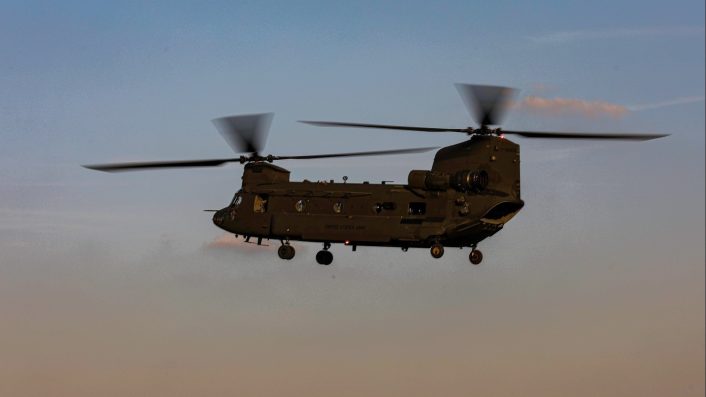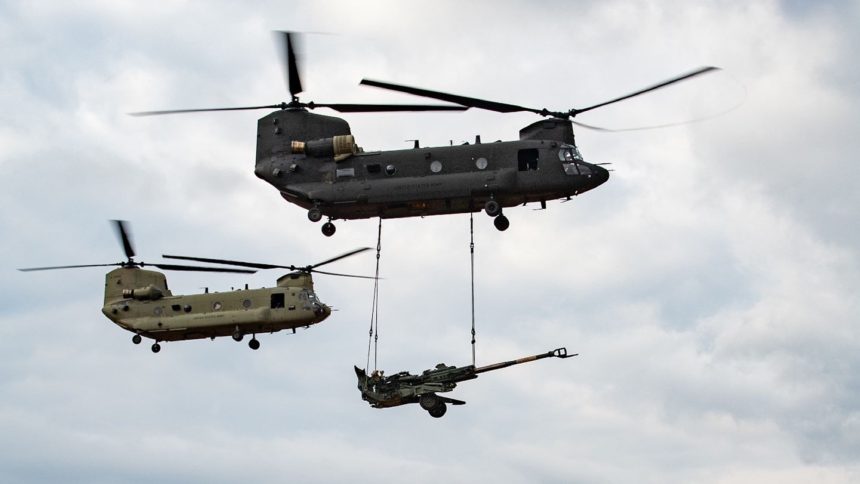The CH-47F Block II has improved efficiency, payload and fuel capacity, critical for the Army’s heavy tactical lift missions.
Boeing announced on Oct. 21, 2025 two contracts from the U.S. Army, worth $461 million, for nine CH-47F Block II Chinook helicopters. Covering Lots 4 and 5, these contracts take the number of the Block II aircraft on order to 18 airframes.
The previous Dec. 4, 2024, contract covering Lot 3 was a $134 million award for three additional CH-47F Chinook Block IIs. The company is also “working closely with the Army on a path forward for Lot 6.”
Since full-rate production began in February 2024, Boeing delivered the first production CH-47F Block II aircraft in June 2024, followed by the second in September. The Army has received so far six CH-47F Block II helicopters, which are “currently undergoing a series of evaluations to demonstrate their enhanced capabilities.”
A Sep. 30, 2025, Army press release, announcing a Rapid Fielding Production decision for CH-47F Block IIs, said the Block II is a “recapitalization” effort, converting existing Block I variants to the new standard. The Army’s current CH-47 fleet stands at 465 aircraft.
Supporting the Army’s pursuit to “advance its heavy-lift modernization efforts,” Boeing’s vice president and program manager for Cargo Programs Heather McBryan said that the “rapid succession of contracts indicates that the Chinook will continue to play an important role in the U.S. Army’s family-of-systems, particularly in a contested logistics environment.”
2️⃣ awards for Block II!
Thank you, @USArmy, for ordering nine CH-47F Block II #Chinook helicopters.
Joining nine aircraft already on contract, these Block II Chinooks will bring enhanced lift, range and sustainment for the missions ahead.
More: https://t.co/aQmTTuvUZR pic.twitter.com/6Yq5yuKk2t
— Boeing Defense (@BoeingDefense) October 21, 2025
CH-47F Block II and future upgrades
The new buy also comes amid Boeing unveiling kinetic launched effects concepts for the Army’s CH-47 fleet, showing expendable munitions – launched from chin-mounted tube launchers – striking ground air defense sites, while operating together with AH-64 Apaches and the Collaborative Transformational Rotorcraft.
These missions are likely to gain prominence in the future both in the European and Pacific theaters, as the Army reorients itself towards conventional wars. The MV-75 tilt-rotor would also be an important element in this mix, rapidly moving Company- or Battalion-sized light infantry formations into defended locations.
🤝 Chinook
🤝 Apache
🤝 Collaborative Transformational Rotorcraft (CxR)
🤝 Advanced midrange interceptors
Together, these platforms give the @USArmy the situational awareness, resilience and flexibility of an entire team.
See how our family of systems links ground, air and… pic.twitter.com/2WINXZVHPe
— Boeing Defense (@BoeingDefense) October 14, 2025
The current CH-47F Block II features significant upgrades, including an improved drivetrain and airframe, increasing the maximum gross weight by 4,000 pounds, and thus significantly increasing lift capability. “Additionally, innovative changes to the fuel system extend the mission radius of nearly all payloads. Combined with enhanced sustainment and the ability to make affordable future upgrades, the CH-47F Block II will meet the Army’s desired goal of flying for at least another 40 years,” said Boeing’s latest statement about the Lot 4 and 5 award.
Boeing has depicted other upgrades to the Block II variant, including elementary autonomous operations in functions like engine control, a new cockpit layout, customizable screens and an open systems architecture for quick future upgrades. “These improvements will ensure that when time flies, the Chinook remains ready to serve,” said the post accompanying the concept video.
A legacy continued … 👀
We’re making moves to enhance CH-47F Block II capabilities — investing in autonomy, open systems architecture and a reimagined cockpit. These improvements will ensure that when time flies, the #Chinook remains ready to serve.#AUSA2025 pic.twitter.com/M30VtSTID3
— Boeing Defense (@BoeingDefense) October 15, 2025
Whether the Army accepts these upgrades as well in the future, and what their retrofitting schedule and downtime would look like, is not known.
A previous experiment-of-sorts upgrade involved re-engining a single CH-47 Chinook with the powerful General Electric T408 engines that power the U.S. Marine Corps CH-53K King Stallion, The War Zone reported in November 2021. The GE T408’s 7,500 shaft horsepower (SHP) rating provides 2,500 SHP more than the Honeywell Lycoming T55 turboshaft engines.
CH-47 Chinook future in the Army
In Boeing’s Dec. 4, 2024, press release about the Lot 3 award, McBryan said the CH-47F Block II’s “increased payload capacity and expanded range enables the U.S. Army to meet evolving heavy-lift mission requirements around the world.” As mentioned earlier, the improved drivetrain and airframe carry 4,000 pounds more payload, “significantly increasing lift capability.”
The Block IIs, according older reports by Aviation Week and FlightGlobal, have an improved Honeywell T55-715 engine, with a defining feature being the three fuel cells combined into a single fuel cell, eliminating intracell fuel transfer hardware, cutting the engine’s weight by 90 kg (200 pounds). This increases fuel capacity, while an active parallel actuator system (APAS) enhances the digital advanced flight control system, accurately splitting the torque between the two rotors for greater efficiency.
The Sep. 30 Army press release also touched upon how the CH-47F Block IIs can use “increased payloads, extended range and improved sustainability to create the standoff areas demanded by contested logistics environments.” The Army explained that, “with an increased maximum gross weight of 54,000 pounds, the aircraft permits operational commanders to move more materiel, Soldiers, and fuel, farther and faster.”
Built different.
The CH-47F Block II #Chinook expands heavy-lift capabilities across the globe.
With redesigned fuel tanks, a strengthened fuselage and an improved drivetrain, the enhanced helicopter can lift more, fly farther and work smarter. See the workhorse in action. pic.twitter.com/12CgIwCtff
— Boeing Defense (@BoeingDefense) October 22, 2025
The U.S. Army also added that the CH-47F Block II has generated “international interest,” with “one partner nation […] committed to 60 aircraft.” While not explicitly stated by the Army, the partner nation is Germany, which selected the helicopter in 2022 to replace its aging CH-53s.
The Block II also shares “commonality” with SOCOM’s (Special Operations Command’s) MH-47G variant, allowing “the Army and SOCOM leverage on each other’s modernization efforts.” Moreover, “[…] the Army reduces both production costs and long-term sustainment expenses, while simplifying logistics,” the Army release said.
The press release quoted Chief Warrant Officer 2 Jordan Brooks, who stressed the Block II Chinook’s “increased gross weight and increased torque” translates into missions that require two sorties with Block Is now needing only a single Block II sortie.
CH-47F Block II Chinook tests with the Army
A Mar. 24, 2025 Army press release revealed the two Special User Evaluation (SUE) trials of the CH-47F Block II Chinook in April and November 2024 by the 101st Combat Aviation Brigade’s General Support Aviation Battalion (GSAB), part of the 101st Combat Aviation Brigade. The “soldier-led assessment of the Block II” provided extensive feedback to the Project Manager.

Aircrew members conducted aerial gunnery tables from rear cabin windows, Fast Rope Insertion and Extraction System (FRIES) training, and additional sling load iterations to familiarize themselves with the increased lifting capacity of the Block II.
Chief Warrant Officer 2 David Lantz, an instructor pilot in Bravo Company 6-101 GSAB, Lantz noted the upgraded software and cockpit displays in the cockpit, allowing easier access to the necessary data to assess the aircraft’s capabilities in various missions. Another feature Lantz said were the four gun mounts, saying “doubling our shooting capability saves us time and fuel in training and will increase lethality overall.”









